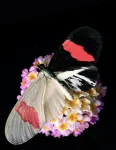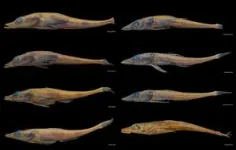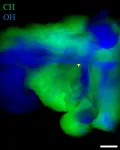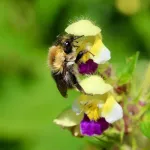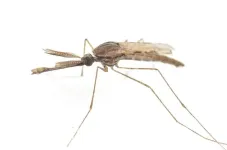(Press-News.org) [Note: High-resolution images related to this research available for download at this link. Caption and credit information provided.]
WASHINGTON (August 30, 2024) — A team of international researchers has uncovered a surprising genetic mechanism that influences the vibrant and complex patterns on butterfly wings. In a study published in the Proceedings of the National Academy of Sciences, the team, led by Luca Livraghi at the George Washington University and the University of Cambridge, discovered that an RNA molecule, rather than a protein as previously thought, plays a pivotal role in determining the distribution of black pigment on butterfly wings.
Precisely how butterflies are able to generate the vibrant patterns and colors on their wings has fascinated biologists for centuries. The genetic code contained within the cells of developing butterfly wings dictates the specific arrangement of the color on the wing’s scales—the microscopic tiles that form wing patterns—similar to the arrangement of colored pixels to form a digital image. Cracking this code is fundamental to understanding how our own genes build our anatomy. In the lab, researchers can manipulate that code in butterflies with gene-editing tools and observe the effect on visible traits, such as coloration on a wing.
Scientists have long known that protein-coding genes are crucial to these processes. These types of genes create proteins that can dictate when and where a specific scale should generate a particular pigment. When it comes to black pigments, researchers thought this process would be no different, and initially implicated a protein-coding gene. The new research, however, paints a different picture.
The team discovered a gene that produces an RNA molecule—not a protein—controls where dark pigments are made during butterfly metamorphosis. Using the genome-editing technique CRISPR, the researchers demonstrated that when you remove the gene that produces the RNA molecule, butterflies completely lose their black pigmented scales, showing a clear link between RNA activity and dark pigment development.
“What we found was astonishing,” said Livraghi, a postdoctoral scientist at GW. “This RNA molecule directly influences where the black pigment appears on the wings, shaping the butterfly’s color patterns in a way we hadn’t anticipated.”
The researchers further explored how the RNA molecule functions during wing development. By examining its activity, they observed a perfect correlation between where the RNA is expressed and where black scales form.
“We were amazed that this gene is turned on where the black scales will eventually develop on the wing, with exquisite precision” said Arnaud Martin, associate professor of biology at GW. “It is truly an evolutionary paintbrush in this sense, and a creative one, judging by its effects in several species.”
The researchers examined the newly discovered RNA in several other butterflies whose evolutionary history diverged around 80 million years ago. They found that in each of these species, the RNA had evolved to control new placements in the patterns of dark pigments.
"The consistent result obtained from CRISPR mutants in several species really demonstrate that this RNA gene is not a recent invention, but a key ancestral mechanism to control wing pattern diversity," said Riccardo Papa, professor of biology at the University of Puerto Rico - Río Piedras.
“We and others have now looked at this genetic trait in many different butterfly species, and remarkably we are finding that this same RNA is used again and again, from longwing butterflies, to monarchs and painted lady butterflies,” said Joe Hanly, a postdoctoral scientist and visiting fellow at GW. “It’s clearly a crucial gene for the evolution of wing patterns. I wonder what other, similar phenomena biologists might have been missing because they weren’t paying attention to the dark matter of the genome.”
The findings not only challenge long-standing assumptions about genetic regulation but also open up new avenues for studying how visible traits evolve in animals.
The study, “A long noncoding RNA at the cortex locus controls adaptive coloration in butterflies,” was published on August 30, 2024 in the Proceedings of the National Academy of Sciences. The research was supported by the National Science Foundation and the Biotechnology and Biological Sciences Research Council.
-GW-
END
Key takeaways
Young griffon vultures move frequently between sleeping sites in different locations, interacting with many friends.
They get set in their ways as they age and roost in the same spots with the same individuals; older vultures follow the same paths.
Roosts act as information hubs; older vultures may have a more thorough knowledge of where to find food resources and less need to learn about them from other vultures.
If you’d rather be watching TV on your couch than dancing at the club, you might have something in common with aging ...
A study by researchers at Baylor College of Medicine and the Jan and Dan Duncan Neurological Research Institute (Duncan NRI) at Texas Children’s Hospital, reveals that the protein Tau – a key player implicated in several neurodegenerative conditions including Alzheimer’s disease – also plays a positive role in the brain. Tau mitigates neuronal damage caused by excessive reactive oxygen species (ROS) or free radicals and promotes healthy aging. The study was published in Nature Neuroscience.
“ROS ...
A doughnut-shaped region thousands of kilometres beneath our feet within Earth’s liquid core has been discovered by scientists from The Australian National University (ANU), providing new clues about the dynamics of our planet’s magnetic field.
The structure within Earth’s liquid core is found only at low latitudes and sits parallel to the equator. According to ANU seismologists, it has remained undetected until now.
The Earth has two core layers: the inner core, a solid layer, and the outer core, a liquid layer. Surrounding the Earth’s core is the mantle. The ...
Researchers from the University of Cincinnati College of Medicine and Cincinnati Children’s Hospital have found a new method to increase both speed and success rates in drug discovery.
The study, published Aug. 30 in the journal Science Advances, offers renewed promise when it comes to discovering new drugs.
“The hope is we can speed up the timeline of drug discovery from years to months,” said Alex Thorman, PhD, co-first author and a postdoctoral fellow in the Department of Environmental and Public ...
The imaging techniques currently used in biological research cannot penetrate into deeper tissue layers. In cancer treatment, this means that remnants of tumors or individual cancer cells at tumor margins and in lymph nodes are not visible. Doctors performing surgery are therefore repeatedly faced with the difficult question of whether all of the affected tissue has actually been removed. For the patient's quality of life, however, the complete removal of the tumor is just as essential as the preservation of healthy tissue ...
To the known risk factors for cardiovascular disease—high blood pressure, high cholesterol, diabetes, overweight and obesity, smoking, and physical inactivity—a new one has to be added: clonal hematopoiesis. This condition is triggered by acquired mutations in blood stem cells and was already known to be associated with an elevated cardiovascular risk. However, until now it was uncertain if clonal hematopoiesis was a cause or consequence of cardiovascular disease. Now, a new study published in Nature Medicine and carried out by researchers at the Centro Nacional de Investigaciones Cardiovasculares (CNIC) resolves this critical debate ...
Climate change is affecting ecosystems in many different ways. One of its consequences are increasingly longer and more intense periods of heat, which affect essential natural processes – such as pollination. A team of researchers from Julius-Maximilians-Universität Würzburg (JMU) has now investigated in more detail how heat affects one particular player in these processes: The bumblebee.
"Bumblebees are important pollinators in natural and agricultural systems. They therefore ...
Attracting around 1,000 participants from industry and academia, the XXVIII EFMC International Symposium on Medicinal Chemistry (EFMC-ISMC) is supposed to take place in Rome, Italy from September 1-5, 2024. After the generative AI updates recently announced on the IMGAIA webinar, Insilico Medicine will be sharing more innovative details while exploring collaboration chances at Booth #50.
EFMC-ISMC is a key symposium in the field of medicinal chemistry and drug discovery, and the symposium this year features ...
COLUMBUS, Ohio – The invention of a tool capable of unlocking previously impossible organic chemical reactions has opened new pathways in the pharmaceutical industry to create effective drugs more quickly.
Traditionally, most drugs are assembled using molecular fragments called alkyl building blocks, organic compounds that have a wide variety of applications. However, because of how difficult it can be to combine different types of these compounds into something new, this method of creation ...
Link to Google Drive folder containing images with caption and credit information:
https://drive.google.com/drive/folders/1UM9rl47Xd_Bs-ov0HpVwC-rtUDonM3oJ?usp=sharing
Post-embargo link to release:
https://www.washington.edu/news/2024/08/30/mosquito-swarm/
Embargoed by Current Biology
For public release at 11 a.m. U.S. Eastern Time (8 a.m. U.S. Pacific Time) on Friday, Aug. 30, 2024
A high-pitched buzzing sound in your ear is an unmistakable sign that a female mosquito is out on the hunt — for they, not males, drink blood. Hearing ...
